The team has powerful characterization tools, adapted to the study of materials developed at the laboratory or resulting from collaborations. The team also benefits from the local context (ESRF, ILL), national and international (BESSY and SOLEIL synchrotrons) which allows a privileged access to large-scale facilities. The guiding idea is on one hand to describe as finely as possible the intrinsic properties of materials and systems (batteries, components, fuel cells, ...) at rest and under chemical, thermal and / or electrical stimulus. These studies require the development of many cells adapted to optical measurements or under X-ray beams or Neutron.
These measurements can trace back, in situ or operando, to the morphological and structural evolutions of materials and interfaces facilitating the understanding of the functioning or degradation mechanisms under use conditions.
Spectroscopy and Raman Imaging
Within the team, the laboratory or via collaboration, Raman spectroscopy is widely used for the characterization of different materials and / or systems (carbon nanostructures, electrode materials, electrolytes, ...). The potential of Raman imaging has been exploited mainly in the context of deformation measurements in microelectronic systems and the simulation of accidental conditions in pool for the storage of spent nuclear fuel and the oxidation of zirconium alloys. The main idea is to access to the physico-chemical quantities by modeling raman line profiles. The extraction of oxygen diffusion coefficients in zirconia required the development of a protocol using a isotopic gas (18O). These research projects also require to manage large amount of data (up to 2M Pixels) using statistical methods.
Operando measurements for understanding Li/S batteries
Operando studies coupling electrochemistry with characterization techniques such as XRD and laboratory X-ray tomography or which required the use of large-scale instruments with studies in XRD, SANS, SAXS, X-ray tomography allowed us to propose reaction mechanisms for sulfur accumulator technologies and to highlight specific adsorption phenomena of polysulphides as well as to study the lithium / electrolyte interface, issues at the heart of current challenges. Studies combining galvanostatic cycling and electrochemical impedance spectroscopy or acoustic emission allowed us to corroborate the proposed mechanisms.



